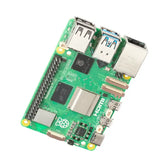How to Disable Sleep Mode in Raspberry Pi
Summary
Tired of your Raspberry Pi going to sleep? Our detailed blog explains how to disable sleep mode and screen blanking. Start with an introduction to these features and their impact on your projects. Learn how to use raspi-config to easily disable screen blanking, and explore alternative methods for keeping your screen active. Gain insight into the Display Power Management Signaling (DPMS) system for advanced control. Perfect for users seeking uninterrupted operation, this guide ensures your Raspberry Pi stays awake. Click now to keep your projects running smoothly!
Introduction
The Raspberry Pi is a flexible and capable single-board computer that has revolutionized how we approach DIY ventures, domestic computerization, and instruction. Its compact estimate and reasonableness make it an perfect choice for a horde of applications.
In any case, one common issue clients confront is the programmed screen blanking or rest mode. This web journal will direct you through understanding and impairing rest mode and screen blanking on your Raspberry Pi.
Introduction to Raspberry Pi
The Raspberry Pi, developed by the Raspberry Pi Establishment, may be a little, reasonable computer outlined to advance computer science instruction and energize experimentation.

Since its dispatch in 2012, the Raspberry Pi has seen various cycles and changes, counting the Raspberry Pi 4, which brags capable determinations that equal numerous conventional PCs. Raspberry Pi's ubiquity stems from its adaptability. It can be utilized as a media center, a retro gaming comfort, a domestic robotization center, and much more. Its GPIO pins moreover permit for simple meddle with a wide run of gadgets, making it a favorite among specialists and creators.
Introduction to Sleep Mode and Screen Blanking
What is Sleep Mode?
Sleep mode, commonly found in PCs and laptops, is a power-saving state that allows a device to quickly resume full-power operation (regularly inside some seconds) once you need to begin working once more. It spares control by cutting off control to non-essential components and lessening control utilization to the Slam, keeping up the current session.
What is Screen Blanking?
Screen blanking on a Raspberry Pi is different from the traditional sleep mode. Instead of putting the entire system into a low-power state, screen blanking essentially turns off the show yield to spare control and anticipate screen burn-in. The Raspberry Pi itself proceeds to run ordinarily and can perform tasks within the foundation indeed when the show is off.
Why Disable Screen Blanking?
Customers might need to cripple screen blanking for a few reasons:
Ceaseless Observing:
For applications like dashboards, advanced signage, or observing frameworks, consistent show yield is vital.
Client Encounter:
In intelligently applications, such as booths or instructive shows, screen blanking can disturb the client involvement.
Improvement and Testing:
Designers regularly require the show to stay dynamic amid testing and investigating sessions.
Using raspi-config to Cripple Screen Blanking
The simplest way to disable screen blanking on your Raspberry Pi is by utilizing the raspi-config utility. This tool provides a user-friendly interface for arranging different framework settings.
Step-by-Step Enlightening
• Open the Terminal: Begin by opening the terminal on your Raspberry Pi. You'll be able do this either straightforwardly on the Raspberry Pi itself or by means of an SSH association.
bash
Duplicate code
sudo raspi-config
- Navigate to Show Choices: Within the raspi-config interface, utilize the bolt keys to explore to Show Choices and press Enter.
- Select Screen Blanking: Inside the Show Choices menu, select Screen Blanking. This choice controls whether the screen ought to naturally turn off after a period of inertia.
- Debilitate Screen Blanking: Select No to cripple screen blanking. This will guarantee that your screen remains on indeed on the off chance that there's no client action.
- Wrap up and Reboot: After making the changes, explore to Wrap up and select it. You will be incited to reboot your Raspberry Pi for the changes to require impact. Select Yes to reboot.
Alternative Strategies for Debilitating Screen Blanking
While raspi-config is the foremost direct method, there are other ways to debilitate screen blanking on a Raspberry Pi.
Method 1: Altering the Autostart Record
Open the Terminal:
Open the terminal on your Raspberry Pi.
bash
Duplicate code
sudo nano /etc/xdg/lxsession/LXDE-pi/autostart
Include the xset Commands:
At the end of the record, include the taking after lines:
bash
Duplicate code
@xset s off
@xset -dpms
@xset s noblank
Spare and Exit:
Press CTRL+X to save the changes, Y to affirm, and Enter to exit the editor.
Reboot:
Reboot your Raspberry Pi to apply the changes.
bash
Duplicate code
sudo reboot
Method 2: Introducing a Screensaver
Another approach is to introduce a screensaver that anticipates screen blanking.
Introduce xscreensaver:
Open the terminal and introduce xscreensaver.
bash
Duplicate code
sudo apt-get introduce xscreensaver
Design xscreensaver:
After establishment, you'll configure it to cripple screen blanking by opening the xscreensaver settings from the menu and setting the screensaver to Blank Screen As it were.

Method 3: Making Use of a GUI
Using the graphical user interface on the Raspberry Pi, you can turn off screen blanking if you'd rather not use the terminal.

Go to Preferences > Raspberry Pi Configuration to access the Preferences menu.
Configure Display Options: Select Screen Blanking as Disabled under the Display tab.

Execute and Reboot: Execute the modifications and restart your Raspberry Pi
Understanding DPMS (Show Control Administration Framework)
Whereas the Raspberry Pi does not have a conventional rest mode like numerous PCs, it does utilize DPMS (Show Control Administration Framework) to oversee the control utilization of the show.
DPMS Values
DPMS has three power-saving states:
- Standby: The show enters a low-power mode but can be rapidly reactivated.
- Suspend: The show enters a more profound power-saving mode, taking marginally longer to wake up.
- Off: The display is completely powered down.
Configuring DPMS
You can configure DPMS settings using the xset command in the terminal.
Bash: xset dpms 600 900 1200 This command sets the standby time to 600 seconds, suspend time to 900 seconds, and off time to 1200 seconds. To disable DPMS entirely, use: Bash: xset -dpms Ensuring DPMS Settings Persist To make sure your DPMS settings persist across reboots, you can add the xset commands to your autostart file.
Edit the Autostart File:
Bash: sudo nano /etc/xdg/lxsession/LXDE-pi/autostart Add the xset Commands: Add the relevant xset commands to the file.
Save and Exit: Save and exit the editor.
Reboot: Reboot your Raspberry Pi.
Conclusion:
Impairing rest mode and screen blanking on a Raspberry Pi can essentially upgrade client involvement, particularly for applications requiring persistent show. Whether through the raspi-config utility, altering framework records, or employing a screensaver, several methods are accessible to attain this.
Understanding DPMS advance permits you to oversee your display's control utilization effectively. By fitting these settings to your particular needs, you'll guarantee that your Raspberry Pi performs ideally for your aiming application. With these instruments and strategies, you'll keep your Raspberry Pi show dynamic and prepared for utilize at all times.










